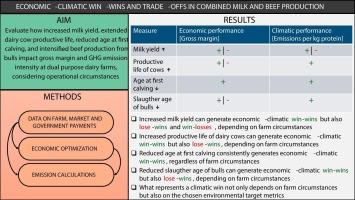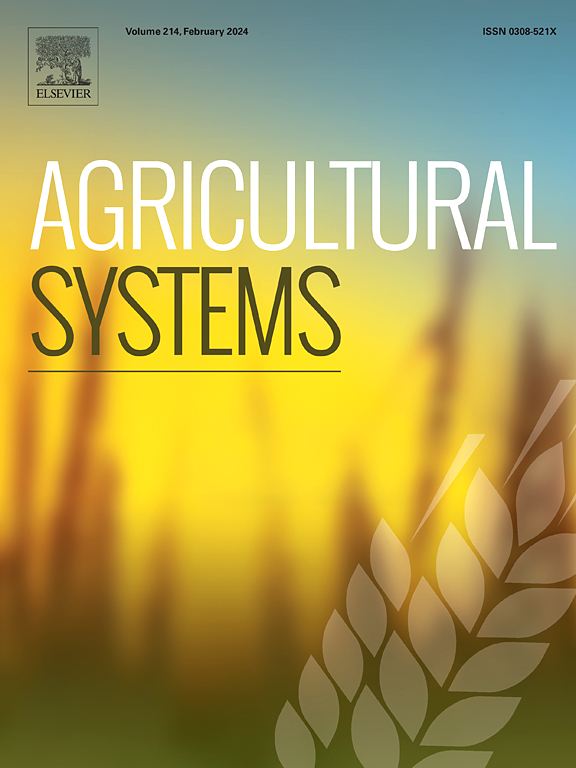Win-win or lose-win? Economic-climatic synergies and trade-offs in dual-purpose cattle systems
IF 6.1
1区 农林科学
Q1 AGRICULTURE, MULTIDISCIPLINARY
引用次数: 0
Abstract
CONTEXT
Researchers have identified numerous strategies to improve economic performance and reduce greenhouse gas (GHG) emission intensity in combined milk and beef production on dairy farms. However, there remains a need to better understand how the effectiveness of these strategies varies under different operational conditions.
OBJECTIVE
This study aims to examine how the economic and GHG emission intensity mitigation effectiveness of increased milk yield, extended longevity of dairy cows, reduced age at first calving, and intensified beef production from bulls depend on operational conditions in dual purpose cattle systems.
METHOD
We present a quantitative framework to (1) economically optimize production at farm level under various constraints and (2) calculate corresponding GHG emissions. The framework is tailored for Norwegian dual-purpose cattle systems and used to assess the economic and GHG emission intensity mitigation effects of incremental adjustments in relevant decisions.
RESULTS AND CONCLUSIONS
The results show that increased milk yield, extended productive life of dairy cows, reduced age at first calving, and lower slaughter age of bulls can lead to economic and climatic win-wins in terms of higher gross margins and reduced emissions per kg of protein produced. However, they may also result in lose-win and win-lose outcomes depending on the operational conditions. All four measures free up roughage production capacity, which, if used to maintain/increase milk and/or beef production, typically results in economic gains. However, if e.g., the available milk quota or space prevent this, economic losses may occur. The climate impact also depends on how the freed-up capacity is used: if it boosts production, the effects vary based on the scale and type of increase and the farm's initial setup, while unused capacity leads to reduced emission intensity. Conflicts typically arise when: 1) the extra capacity increases less climate-friendly production, raising emission intensity despite economic gains, or 2) extra capacity cannot be used, causing economic losses despite climate benefits. Our results also show that what can be labeled a win in climate terms, and to what extent, depends on the selected target metric(s).
SIGNIFICANCE
Governments and societies strive to balance food production with environmental goals. In this context, it is essential to identify farm-level economic and climatic win-win and lose-win scenarios, not only for farmers but also for policymakers and the broader society. This study could inform decision-making and policy development, potentially enhancing economic and climatic performance in combined milk and meat production.

双赢还是双输?牛群两用系统的经济-气候协同效应与权衡
内容提要研究人员已经确定了许多策略,以提高奶牛场牛奶和牛肉联合生产的经济效益并降低温室气体(GHG)排放强度。本研究旨在探讨提高产奶量、延长奶牛寿命、降低初产牛犊年龄和加强公牛牛肉生产等措施的经济效益和减少温室气体排放强度的效果如何取决于奶牛两用系统的运行条件。方法我们提出了一个定量框架,用于(1)在各种约束条件下对农场生产进行经济优化,以及(2)计算相应的温室气体排放量。结果和结论结果表明,提高产奶量、延长奶牛的生产寿命、降低初产年龄和降低公牛的屠宰年龄,可以实现经济和气候双赢,即提高毛利率和减少每公斤蛋白质的排放量。不过,根据不同的操作条件,这些措施也可能导致双输或双输的结果。所有四项措施都释放了粗饲料生产能力,如果用于维持/增加牛奶和/或牛肉产量,通常会带来经济收益。但是,如果可用的牛奶配额或空间等因素阻碍了这一点,则可能出现经济损失。对气候的影响还取决于如何使用腾出的产能:如果产能提高了产量,其影响会因增加的规模和类型以及牧场的初始设置而不同,而未使用的产能则会导致排放强度降低。通常在以下情况下会出现冲突1) 额外产能增加了对气候不那么友好的生产,尽管带来了经济收益,却提高了排放强度;或 2) 额外产能无法使用,尽管带来了气候效益,却造成了经济损失。我们的研究结果还表明,从气候角度看,什么是赢,赢的程度如何,取决于所选的目标指标。 意义各国政府和社会都在努力平衡粮食生产与环境目标。在这种情况下,不仅对农民,而且对政策制定者和更广泛的社会而言,确定农场层面的经济和气候双赢和双输方案至关重要。这项研究可为决策和政策制定提供信息,从而有可能提高奶类和肉类联合生产的经济和气候绩效。
本文章由计算机程序翻译,如有差异,请以英文原文为准。
求助全文
约1分钟内获得全文
求助全文
来源期刊

Agricultural Systems
农林科学-农业综合
CiteScore
13.30
自引率
7.60%
发文量
174
审稿时长
30 days
期刊介绍:
Agricultural Systems is an international journal that deals with interactions - among the components of agricultural systems, among hierarchical levels of agricultural systems, between agricultural and other land use systems, and between agricultural systems and their natural, social and economic environments.
The scope includes the development and application of systems analysis methodologies in the following areas:
Systems approaches in the sustainable intensification of agriculture; pathways for sustainable intensification; crop-livestock integration; farm-level resource allocation; quantification of benefits and trade-offs at farm to landscape levels; integrative, participatory and dynamic modelling approaches for qualitative and quantitative assessments of agricultural systems and decision making;
The interactions between agricultural and non-agricultural landscapes; the multiple services of agricultural systems; food security and the environment;
Global change and adaptation science; transformational adaptations as driven by changes in climate, policy, values and attitudes influencing the design of farming systems;
Development and application of farming systems design tools and methods for impact, scenario and case study analysis; managing the complexities of dynamic agricultural systems; innovation systems and multi stakeholder arrangements that support or promote change and (or) inform policy decisions.
 求助内容:
求助内容: 应助结果提醒方式:
应助结果提醒方式:


